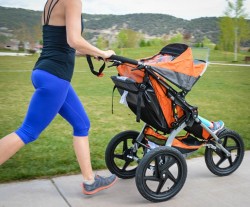 Michelle Bridges has come under fire recently for her pregnancy and post-natal exercise advice, with experts claiming that her suggestions and examples are irresponsible, and send women the wrong message.
Michelle Bridges has come under fire recently for her pregnancy and post-natal exercise advice, with experts claiming that her suggestions and examples are irresponsible, and send women the wrong message.
In November 2015 she was criticised when she was photographed doing fit ball crunches in her third trimester. Performing direct abdominal exercises like crunches and leg raises places excessive load on the line alba (where the ‘6-pack’ muscles meet in the middle) and can lead to rectus abdominus diastasis – a condition where the abdominal muscles tear and separate, affecting two thirds of women in their third trimester.
Then just 3 weeks after giving birth to her son, she detailed her post-natal workout on Instagram, advising ‘jogging’ as an effective method of exercise for other women as they recover from childbirth. The problem with jogging is that the bouncing movement places a large amount of stress on the pelvic floor and other ligaments that support the bladder, uterus and bowel. Extensive strengthening of these muscles needs to occur before any kind of high impact or heavy lifting exercise is attempted post-natal.
Placing too much stress on these areas before they have fully recovered from pregnancy and child birth is highly likely to cause incontinence.
So what should you do?
While direct abdominal exercises like full crunches and leg raises can place excessive stress on the already weakened abdominal muscles, you can engage these muscles with gentle strengthening exercises like the abdominal vacuum, pelvic tilts and pelvic floor exercises during pregnancy. These are very helpful gentle exercises to begin with in post natal recovery to start getting the deep abdominal and pelvic floor muscles back to their pre-pregnancy condition.
Instead of jogging, once you are up and about, start with very gentle walking and wait until you have medical clearance from your doctor before completing anything high impact. Once you have medical clearance, you still need to increase your exercise intensity and volume GRADUALLY. This will be based on a combination of how active you were before and during your pregnancy, how your labour and delivery went, how your recovery is going, and how you feel. It’s a very personal and individual time and you should only do what you feel comfortable with.
It can be difficult to find time alone to exercise without the baby, so why not find ways to exercise WITH your baby. Apart from grabbing the stroller and going for a walk, there are many different movements to increase your heart rate and engage your muscles that can also be a fun bonding experience with your baby.
Bottom line
While it is a nice idea to try to imitate what other professional Trainers and athletes complete in their own post-natal exercise routines, a much better idea is to follow doctor’s order, and find a gentle, common sense workout routine that is right for you!
